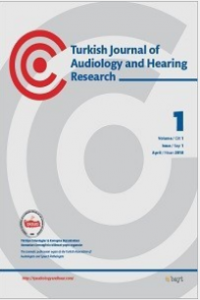Auditory responses and behavioral patterns in children with autism spectrum disorder: A case series
Otizm Spektrum Bozukluğu (OSB) olan çocuklar dil gelişimindeki gecikme sebebiyle genellikle odyolojik değerlendirme için yönlendirilir. Bu çalışmanın amacı, OSB olan çocukların işitsel cevap ve davranış örüntülerini göstermek ve odyolojik test bataryasının birlikte yorumlanmasının önemini vurgulamaktır. Otizm Spektrum Bozukluğu ile takip edilen üç olgunun işitme testi bulguları değerlendirilmiştir. Olguların işitsel uyaranlara verdikleri cevaplar değişiklik göstermektedir. Otizmli çocuklarda, gerek güvenilir işitme testi sonucuna ulaşabilmek için gerekse doğru yönlendirme ve yaklaşımın belirlenebilmesi için, otizmli çocukların işitsel cevap ve davranış örüntülerinin alanda çalışan odyologlar ve ilgili diğer meslek grupları tarafından bilinmesi oldukça önemlidir.
Anahtar Kelimeler:
: behavioral assessment, hearing, hearing loss, autism spectrum disorder
Auditory Responses and Behavioral Patterns in Children with Autism Spectrum Disorder: A Case Series
Children with Autism Spectrum Disorder (ASD) are consulted for the audiological assessment because of delayed language development. This study aimed to show auditory response and behavior patterns in children with ASD and to show the importance of interpreting audiological findings together. Subjective and objective audiological tests were applied to three children. Given responses to the auditory stimulus change in these children. Characteristics of their auditory and behavioral patterns must be known by audiologists and other specialists, who are working with ASD, both to obtain to reliability hearing results and to determine suitable consultation and approach in children with ASD.
___
- APA. (1994). American Psychiatric Association Diagnostic and statistical manual of mental disorders (4 th ed.). Washington DC: American Psychiatric Association.
- Berard, G. (1993). Hearing Equals Behavior. New Canaan, CT: Keats Publishing.
- Danesh, A., Kaf WA, Abdelhakiem MK, Danesh D. (2015). Auditory Manifestations and Intervention in Children with Autism Spectrum Disorders. J Autism & Relat Disabil, 1(1), 1005.
- Darıca, N., Abidoğlu Ü, Gümüşçü Ş. (2005). Otizm ve Otistik Çocuklar: Özgür Yayınları.
- Downey, D., Mraz, R., Knott, J., Knutson, C., Holte, L., & Van Dyke, D. (2002). Diagnosis and evaluation of children who are not talking. J Infants Young Children, 15(2), 38-48.
- Gravel, J., Dunn M, Lee WW,Ellis ME. (2006). Peripheral audition of children on the autistic spectrum. Ear & Hearing, 299 - 312.
- Lincoln, A., Courchesne E, Harms L, Allen M. (1995). Sensory modulation of auditory stimuli in children with autism and receptive developmental language disorder: event-related brain potential evidence. Journal of Autism and Developmental Disorders, 25, 521 - 539.
- Madell, J., Flexer C (2008). Pediatric Audiology: Diagnosis, Technology and Management: Thieme Medical Pulishers.
- O’connor, K. (2012). Auditory processing in autism spectrum disorder: a review. Neuroscience Biobehavioral Reviews, 36(2), 836-854.
- Ring, H., Baron CS, Wheelwright S, Williams SC, Brammer M, Andrew C, et al. (1999). Cerebral correlates of preserved cognitive skills in autism: a functional MRI study of embedded figures task performance. Brain, 122, 1305 - 1315.
- Rosenhall, U., Nordin, V., Sandström, M., Ahlsen, G., & Gillberg, C. (1999). Autism and hearing loss. Journal of Autism Developmental Disorders, 29(5), 349-357.
- Tharpe, A. M., Bess, F. H., Sladen, D. P., Schissel, H., Couch, S., & Schery, T. (2006). Auditory characteristics of children with autism. Ear & Hearing, 27(4), 430-441.
- ISSN: 2651-3757
- Başlangıç: 2018
- Yayıncı: Odyoloji Konuşma ve Ses Bozuklukları Derneği
Sayıdaki Diğer Makaleler
İşitme Cihazı Kullanıcısı Çocuklarda Fonem Ayırt Etme Becerileri: Preliminer Sonuçlar
Erva Değirmenci UZUN, Merve BATUK, Gonca SENNAROĞLU
Kafa Travmasına Bağlı Benign Paroksismal Pozisyonel Vertigo ve Klinik Özellikleri
MÜZİKTE SENSÖR DİSONANS VE MÜZİK EĞİTİMİNİN ETKİSİ
Gonca SENNAROĞLU, Ayça ÇİPTUR, Ahmet ATAŞ, Günay KIRKIM, Meral Didem TÜRKYILMAZ, Şule KAYA, Görkem ERTUĞRUL, Sevtap KUTLAY, Engin DANIŞMEN, Muammer GÜLTEKİN
Auditory responses and behavioral patterns in children with autism spectrum disorder: A case series
